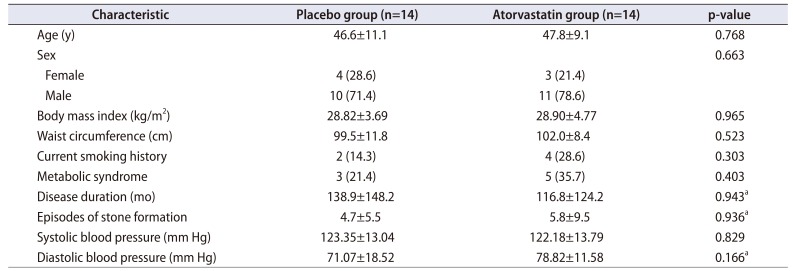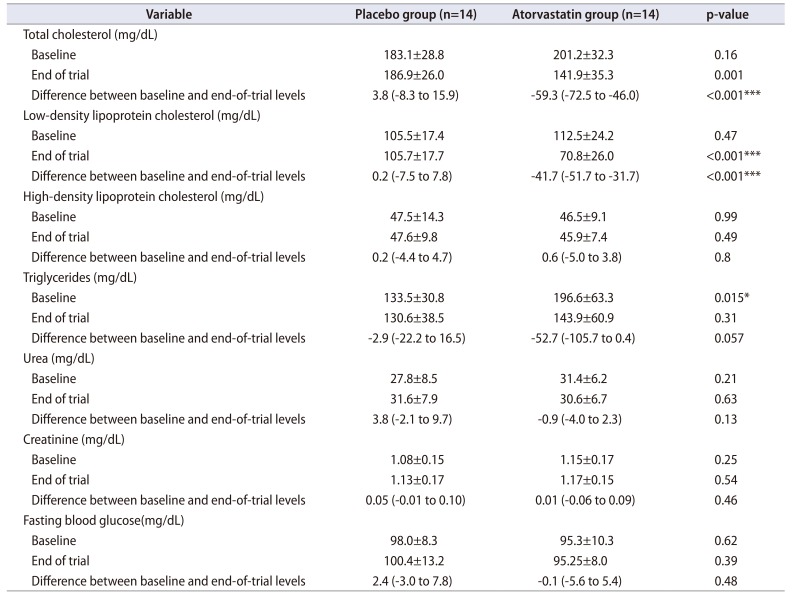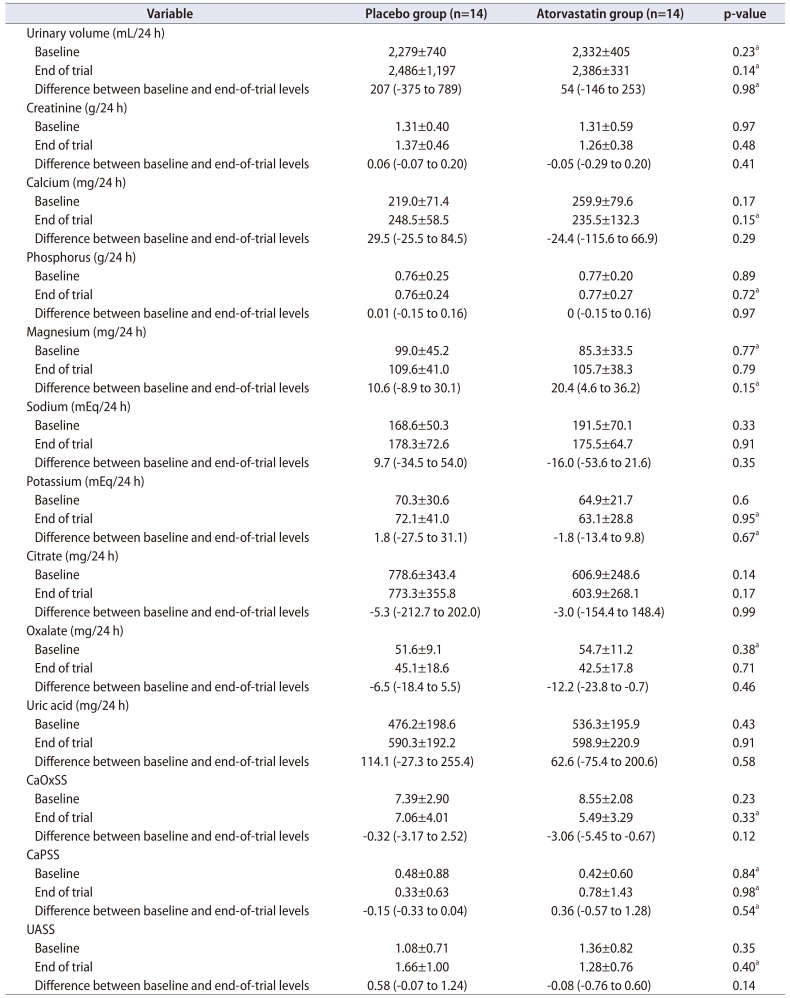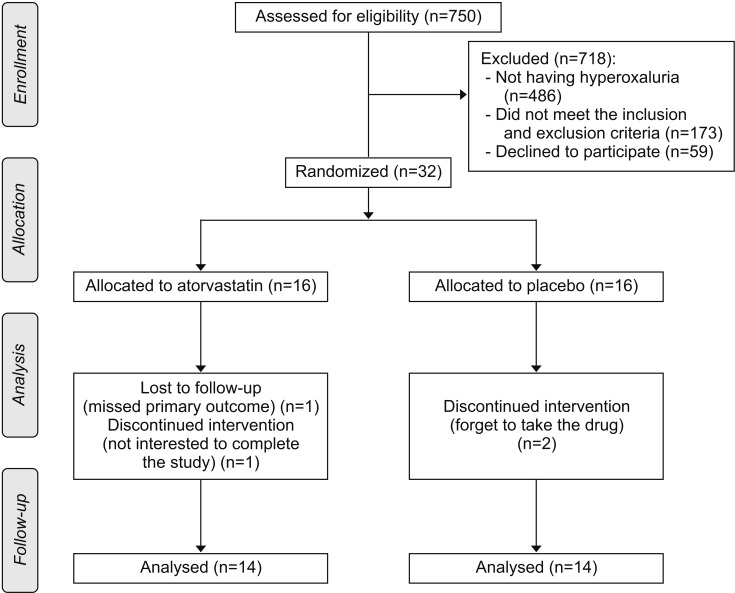1. Pourmand G, Pourmand B. Epidemiology of stone disease in Iran. In : Talati JJ, Tiselius HG, Albala DM, Ye Z, editors. Urolithiasis: basic science and clinical practice. London: Springer;2012. p. 85–87.
2. Masterson JH, Woo JR, Chang DC, Chi T, L'Esperance JO, Stoller ML, et al. Dyslipidemia is associated with an increased risk of nephrolithiasis. Urolithiasis. 2015; 43:49–53. PMID:
25193087.

3. Sur RL, Masterson JH, Palazzi KL, L'Esperance JO, Auge BK, Chang DC, et al. Impact of statins on nephrolithiasis in hyperlipidemic patients: a 10-year review of an equal access health care system. Clin Nephrol. 2013; 79:351–355. PMID:
23195830.

4. Cohen AJ, Adamsky MA, Nottingham CU, Pruitt J, Lapin B, Wang CH, et al. Impact of statin intake on kidney stone formation. Urology. 2019; 124:57–61. PMID:
29421299.

5. Tsujihata M, Momohara C, Yoshioka I, Tsujimura A, Nonomura N, Okuyama A. Atorvastatin inhibits renal crystal retention in a rat stone forming model. J Urol. 2008; 180:2212–2217. PMID:
18804815.

6. Tsujihata M, Yoshioka I, Tsujimura A, Nonomura N, Okuyama A. Why does atorvastatin inhibit renal crystal retention. Urol Res. 2011; 39:379–383. PMID:
21400107.

7. Temiz MZ, Yuruk E, Ertas K, Zengi O, Semercioz A. Effects of statin treatment with atorvastatin on urolithiasis-associated urinary metabolic risk factors: an experimental study. Int Urol Nephrol. 2018; 50:231–236. PMID:
29197934.

8. Kumar A, Hecht C, Priyamvada S, Anbazhagan AN, Alakkam A, Borthakur A, et al. Probiotic Bifidobacterium species stimulate human SLC26A3 gene function and expression in intestinal epithelial cells. Am J Physiol Cell Physiol. 2014; 307:C1084–C1092. PMID:
25143346.

9. Chow SC, Shao J, Wang H. Sample size calculations in clinical research. 2nd ed. Boca Raton: Taylor & Francis;2007. p. 60.
10. Skolarikos A, Straub M, Knoll T, Sarica K, Seitz C, Petřík A, et al. Metabolic evaluation and recurrence prevention for urinary stone patients: EAU guidelines. Eur Urol. 2015; 67:750–763. PMID:
25454613.

11. Farmer KC. Methods for measuring and monitoring medication regimen adherence in clinical trials and clinical practice. Clin Ther. 1999; 21:1074–1090. PMID:
10440628.

12. Noori N, Honarkar E, Goldfarb DS, Kalantar-Zadeh K, Taheri M, Shakhssalim N, et al. Urinary lithogenic risk profile in recurrent stone formers with hyperoxaluria: a randomized controlled trial comparing DASH (Dietary Approaches to Stop Hypertension)-style and low-oxalate diets. Am J Kidney Dis. 2014; 63:456–463. PMID:
24560157.

13. Satoh K. Serum lipid peroxide in cerebrovascular disorders determined by a new colorimetric method. Clin Chim Acta. 1978; 90:37–43. PMID:
719890.
14. Tavasoli S, Basiri A, Khoshdel A, Taheri M. Evaluating the association of body mass index, waist circumference and waist to stature ratio with urine composition in patients with urolithiasis. Iran J Kidney Dis. 2017; 11:371–378. PMID:
29038393.
15. Santhosh Kumar M, Selvam R. Supplementation of vitamin E and selenium prevents hyperoxaluria in experimental urolithic rats. J Nutr Biochem. 2003; 14:306–313. PMID:
12873711.

16. Fry DW, Richardson KE. Isolation and characterization of glycolic acid oxidase from human liver. Biochim Biophys Acta. 1979; 568:135–144. PMID:
444540.

17. Steinhubl SR. Why have antioxidants failed in clinical trials? Am J Cardiol. 2008; 101(10A):14D–19D.

18. Parthasarathy S, Khan-Merchant N, Penumetcha M, Khan BV, Santanam N. Did the antioxidant trials fail to validate the oxidation hypothesis. Curr Atheroscler Rep. 2001; 3:392–398. PMID:
11487450.

19. Kok DJ, Boellaard W, Ridwan Y, Levchenko VA. Timelines of the “free-particle” and “fixed-particle” models of stone-formation: theoretical and experimental investigations. Urolithiasis. 2017; 45:33–41. PMID:
27915394.

20. Ma MC, Chen YS, Huang HS. Erythrocyte oxidative stress in patients with calcium oxalate stones correlates with stone size and renal tubular damage. Urology. 2014; 83:510.e9–510.e17.

21. Boonla C, Wunsuwan R, Tungsanga K, Tosukhowong P. Urinary 8-hydroxydeoxyguanosine is elevated in patients with nephrolithiasis. Urol Res. 2007; 35:185–191. PMID:
17541572.

22. Carnevale R, Pignatelli P, Di Santo S, Bartimoccia S, Sanguigni V, Napoleone L, et al. Atorvastatin inhibits oxidative stress via adiponectin-mediated NADPH oxidase down-regulation in hypercholesterolemic patients. Atherosclerosis. 2010; 213:225–234. PMID:
20832062.

23. Zhu W, Liu M, Wang GC, Che JP, Xu YF, Peng B, et al. Urinary neutrophil gelatinase-associated lipocalin, a biomarker for systemic inflammatory response syndrome in patients with nephrolithiasis. J Surg Res. 2014; 187:237–243. PMID:
24239146.

24. Kandur Y, Gonen S, Fidan K, Soylemezoglu O. Evaluation of urinary KIM-1, NGAL, and IL-18 levels in determining early renal injury in pediatric cases with hypercalciuria and/or renal calculi. Clin Nephrol. 2016; 86:62–69. PMID:
27345186.

25. Carrasco-Valiente J, Anglada-Curado FJ, Aguilar-Melero P, González-Ojeda R, Muntané-Relat J, Padillo-Ruiz FJ, et al. [State of acute phase markers and oxidative stress in patients with kidney stones in the urinary tract]. Actas Urol Esp. 2012; 36:296–301. Spanish. PMID:
22301017.

26. Tungsanga K, Sriboonlue P, Futrakul P, Yachantha C, Tosukhowong P. Renal tubular cell damage and oxidative stress in renal stone patients and the effect of potassium citrate treatment. Urol Res. 2005; 33:65–69. PMID:
15565439.

27. Devarajan P. Neutrophil gelatinase-associated lipocalin: a promising biomarker for human acute kidney injury. Biomark Med. 2010; 4:265–280. PMID:
20406069.

28. Taşdemir M, Fuçucuoğlu D, Küçük SH, Erol M, Yiğit Ö, Bilge I. Urinary biomarkers in the early detection and follow-up of tubular injury in childhood urolithiasis. Clin Exp Nephrol. 2018; 22:133–141. PMID:
28653226.









 PDF
PDF ePub
ePub Citation
Citation Print
Print




 XML Download
XML Download